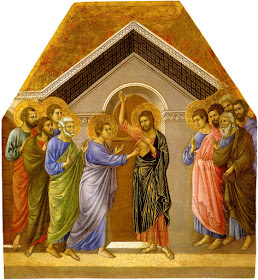 Today we celebrate the saint for all who have doubts, and still believe: St. Thomas. Thinking of this I am reminded of the great painting by Duccio in the Maesta Altarpiece in Siena - 'L'Incredulita di san Tommaso'. Seems like a lifetime ago when first saw this in Siena, and fell in love with Duccio. It is this picture which forms my mental image of the episode relate in St. John's Gospel. In the altarpiece Duccio brings out the contrast as between Jesus's request to St Mary Magdalene not to touch Him, (below) and his later invitation to St. Thomas - who could not believe that Jesus was alive - to touch the wound made by the spear which pieced His heart.
Today we celebrate the saint for all who have doubts, and still believe: St. Thomas. Thinking of this I am reminded of the great painting by Duccio in the Maesta Altarpiece in Siena - 'L'Incredulita di san Tommaso'. Seems like a lifetime ago when first saw this in Siena, and fell in love with Duccio. It is this picture which forms my mental image of the episode relate in St. John's Gospel. In the altarpiece Duccio brings out the contrast as between Jesus's request to St Mary Magdalene not to touch Him, (below) and his later invitation to St. Thomas - who could not believe that Jesus was alive - to touch the wound made by the spear which pieced His heart.St. John's Gospel is very much the gospel of the Sacred Heart: he gives the account St. John resting on Christ's breast, of the spear piercing the heart, and the flow of blood and water, and he also relates the incident with Thomas. And yet, when we reflect on the devotion to the Sacred Heart - and certainly the art work associated with the image, St Thomas does not figure very much - if at all. But when you think about it St Thomas is really the first Saint of the Heart of Jesus. Only he was to touch the wound from which flowed the blood and water mentioned in the Gospel. Having said this, I can discern little in the history of the devotion which makes this association of the Heart of Christ and St. Thomas. Even so, Pius XII in Haurietis Acquas (1956) reminds us that, if we are to better understand the Sacred Heart we must be mindful of the role of St Thomas, and what his response was to Christ's invitation to touch his wounded side: 'My Lord and my God'.
Thomas stands for modern man: we want proof. We want evidence. Perhaps we should remember that the devotion to the Sacred Heart in its modern form came about at a time when the 'enlightenment' was burning so fiercely in France. It was the age of reason: the age of proof and evidence. It was the age of Thomas. Into the middle of this revolution comes the devotion to the Sacred Heart: a reminder that faith and reason are not incompatible, but complementary. Jesus does not condemn Thomas for his lack of faith, on the contrary he says ' here touch my wounded heart.' Jesus understands that humanity is both a creature of faith and reason and together they form our heart- our inner self. Jesus shows to Thomas the reality of his love for humanity: and in His heart we see our Lord and our God. It seems to me that the revelation of the Sacred Heart is a kind of re-run of the incident with Thomas. It is as if Christ is saying : you want proof? The proof is in the heart that so loves the world. Christ is asking us to touch Him and open ourselves to experience the Love of God. 'Doubt no longer, but believe'.

No comments:
Post a Comment